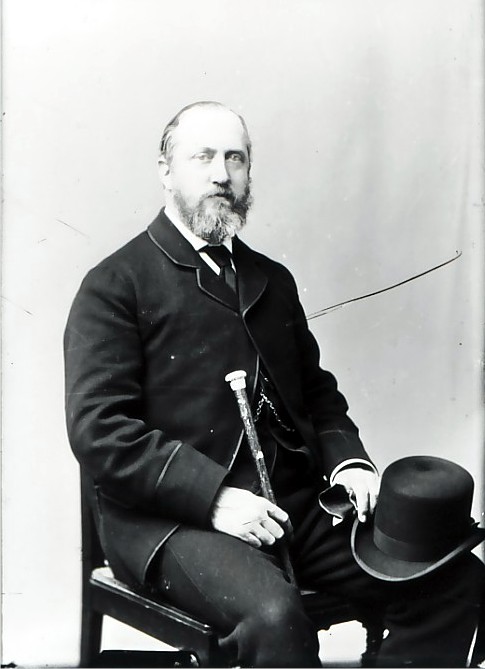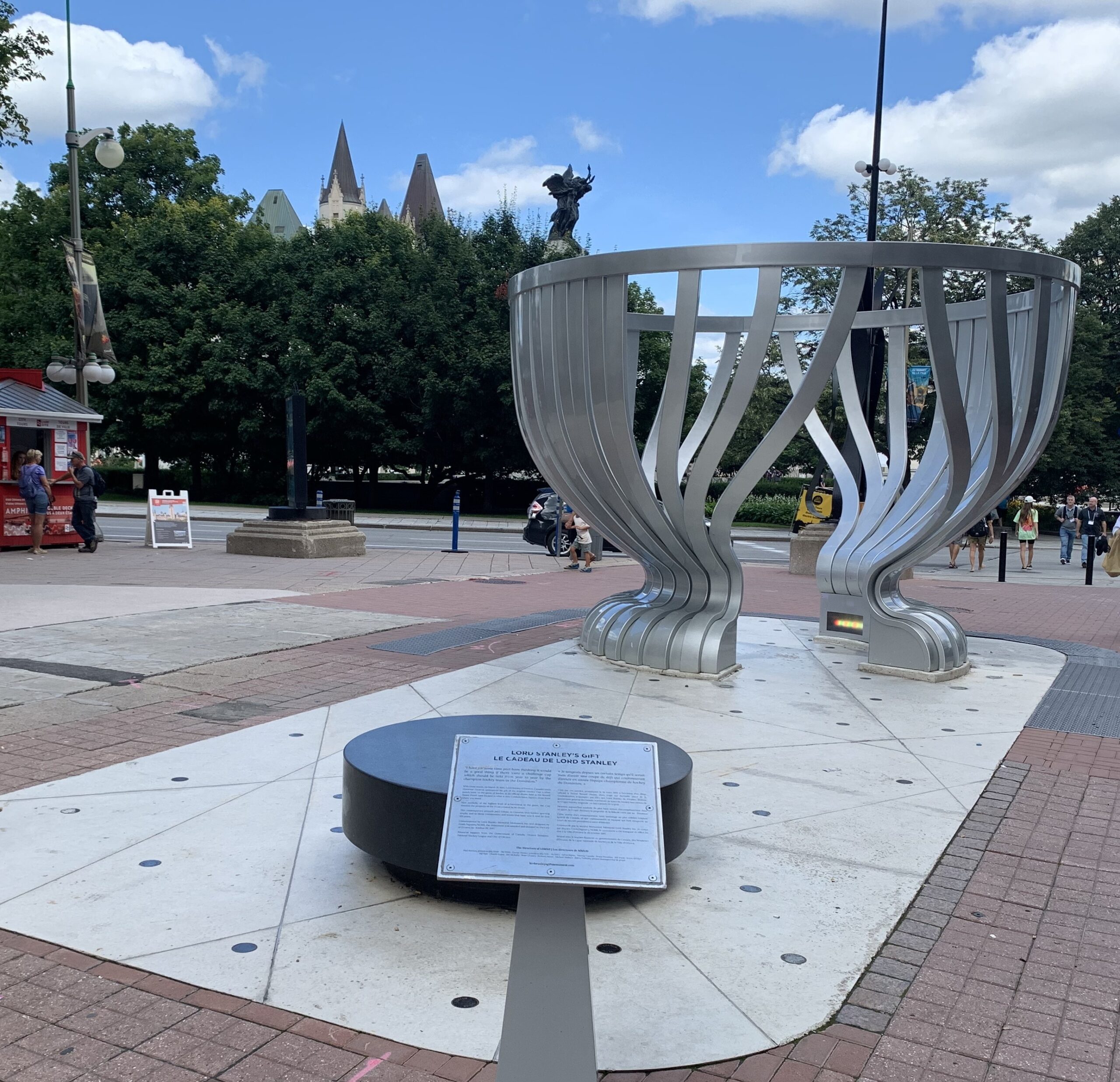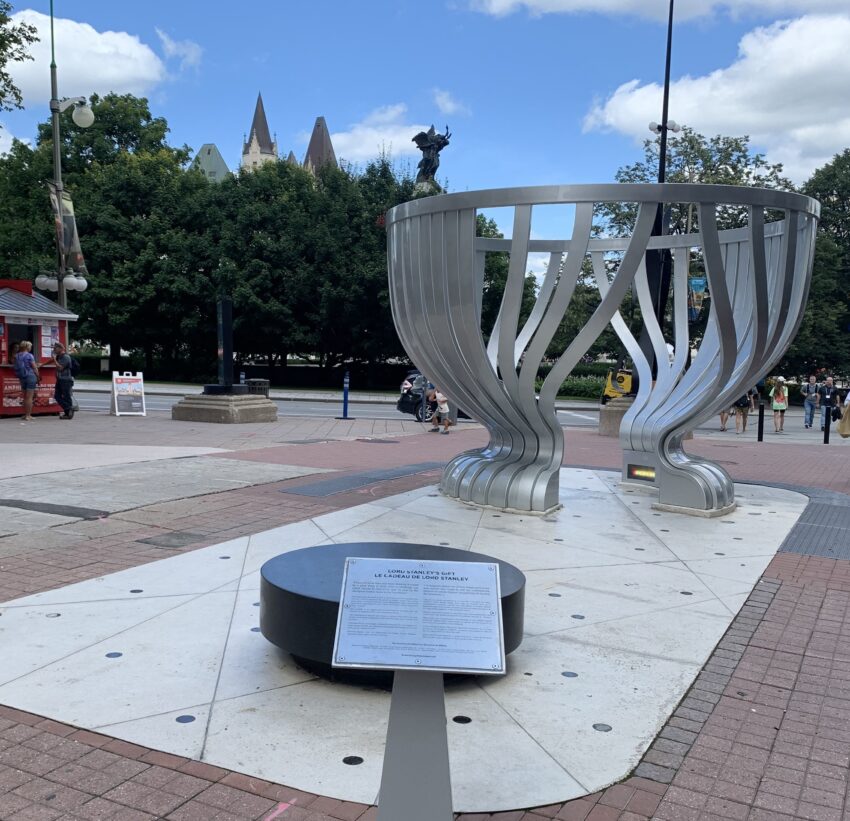Canada’s sixth governor general was born in London, England on January 15, 1841, the second son of three-times Prime Minister Edward George Geoffrey Stanley. He was educated at Eton College and at age seventeen joined the Grenadier Guards, retiring as a captain in 1865. That year he was elected to the British House of Commons as the Conservative MP for Preston. In 1864 he married Lady Constance Villiers and they had eight sons and two daughters. In a lengthy political career Stanley held a number of important positions, including Financial Secretary to the War Office, Secretary of State for War, and Colonial Secretary.
On being offered the governor generalship of Canada in February 1888, Stanley quickly accepted and by June was in Canada with Lady Constance and four of their children. By all accounts, the Stanley family took well to their new surroundings and became popular throughout the country.
With the death of his elder brother in April 1893, Stanley resigned office and in July left Canada to look after the family estate at home. He remained publicly active, serving as Lord Mayor of Liverpool, and president of the British Empire League, as well as being a successful racehorse owner. Stanley died of heart failure on June 14, 1908.

Lord Stanley of Preston. Photo: LIBRARY AND ARCHIVES CANADA PA25686
Origin of the Stanley Cup
When Lord Stanley of Preston was appointed governor general in 1888, hockey was in its earliest years. It is generally accepted that the first game of organized, indoor hockey (identified teams, rules, recorded score) was played at the Victoria Rink in Montreal on March 3, 1875. Gradually, the version played in Montreal expanded east to Quebec City and west to Ottawa. Hockey in varying unstructured forms had been played in Nova Scotia for many years. But it was the Montreal Winter Carnival tournaments of 1883, 1884 and 1885 that first drew broad popular attention to the sport.
In his first Canadian winter (1889), Lord Stanley attended a match at the Victoria Rink in Montreal and became intrigued with the game. Six of Stanley’s sons (Algernon, Arthur, Edward, Ferdinand, George, and Victor) are known to have taken up the sport during their time in Ottawa. In November 1890, Arthur Stanley was a member of a delegation attending a meeting in Toronto to organize an “Ontario Hockey Association” (OHA). There were now two structured organizations – the Amateur Hockey Association of Canada (centred in Montreal) and the OHA.
In March 1892, after the Ottawa Hockey Club had won its second consecutive Ontario championship, the Ottawa Amateur Athletic Association organized a dinner to honour the team. At that dinner, Lord Kilcoursie, an aide to Lord Stanley, read out a letter from the governor general offering to donate “a challenge cup which should be held from year to year by the champion hockey team of the Dominion”.
Stanley asked his military secretary Captain Charles Colville, who was in England at the time, to secure a cup. What Colville requisitioned was a late Victorian electroplate silver punch bowl, with a plain moulded rim above a repousse swirl-fluted and shaped band, above a plain inscription band crested and inscribed ‘From Stanley of Preston’ and ‘Dominion Hockey Challenge Cup.’

The original Stanley Cup. Image: LIBRARY AND ARCHIVES CANADA
The Original Trophy
The original Stanley Cup is a silver punch bowl, 18.5 cm. in height and 29 cm. in diameter, resting on an ebony column bearing a silver plaque identifying the trophy as a gift from Lord Stanley of Preston.
Over the years bands bearing the names of winning teams and players were added, such that the trophy took on a stovepipe appearance. The Cup has undergone re-designs, with new enlarged bands added. As each new band is filled, the earliest one is removed and displayed in the Hockey Hall of Fame.
Today, the Stanley Cup exists in three incarnations: the original bowl, which was retired to the Hockey Hall of Fame in 1970; a presentation Stanley Cup, which is used for ceremonies and for display at the Hall of Fame and elsewhere; and a replica Stanley Cup, which is displayed at the Hall when the presentation cup is travelling.
Lord Stanley’s Gift Monument
A contemporary artwork, located on the eastern end of the Sparks Street Mall in Ottawa, pays tribute to Canada’s best-known sporting trophy, and to those communities and teams that have won it over its first 125 years.
Lord Stanley’s Gift is an elegant 3.45 M high chalice fabricated from silvered aluminum bands, parted to invite visitors to pass through it with framed views to the National War Memorial. The sculpture rises from a white paved “hockey rink” with imbedded stainless steel lines evoking skate marks and 39 granite discs engraved with the names of the Stanley Cup winners from 1893 to 2017. A 1.4 M diameter black granite bench in the form of a “hockey puck” completes the ensemble.
Commissioned by Lord Stanley’s Memorial Monument Inc. and designed by Covit/Nguyen/ NORR, the monument was unveiled and donated to the City of Ottawa on October 28, 2017.

Lord Stanley’s Gift Monument, looking east to Elgin Street, Ottawa.
Stanley Cup Holders and Winners
In its early years, the Stanley Cup was a challenge trophy, meaning that the champion team of any senior league was eligible to compete for it against the current holder. The cup could therefore change hands during the course of a season. In the first ten years in which the cup was awarded (1893-1903), teams representing five associations in Quebec, Ontario, the Maritimes, and Manitoba competed for it at one time or another.
In 1907 the Eastern Canada Amateur Hockey Association, the premier senior league, formally began allowing professionals to participate and in 1909 dropped the word “Amateur” from its name. In 1910 a new professional league, the National Hockey Association (NHA), began play and from then through 1913 the NHA champion competed against the champions of other professional leagues for the cup.
In 1914, the Stanley Cup series became an annual competition between the top teams of the two leading professional leagues, the NHA and the Pacific Coast Hockey Association (PCHA). This annual east/west series ended in 1926 when the successor league to the PCHA, the Western Hockey League, dissolved.
Since the National Hockey League, which replaced the NHA, was the only remaining premier professional league, it was no longer possible to have premier-level, inter-league competition for the cup. Therefore, in 1927 the Stanley Cup, by default, became the championship trophy, exclusively, of the NHL.
First 125 Years
Challenge Era: 1892-93 to 1925-26
The Stanley Cup was not awarded in 1919 as the Spanish influenza epidemic halted the series between the Montreal Canadiens and the Seattle Metropolitans.
Asterisk indicates won and then lost Cup or lost and then won Cup in same season.
- Kenora Thistles 1906-07*
- Montreal AAA 1902-03*, 1901-02*, 1893-94, 1892, 1893
- Montreal Canadiens 1923-24, 1915-16
- Montreal Maroons 1925-26
- Montreal Shamrocks 1899-1900, 1898-99
- Montreal Wanderers 1909-10, 1907-08, 1906-07*, 1905-06*
- Montreal Victorias 1897-98, 1896-97, 1895-96*, 1895-96
- Ottawa Senators 1922-23, 1920-21, 1919-20, 1910-11, 1908-09, 1905-06*, 1904-05, 1903-04, 1902-03*
- Quebec Bulldogs 1912-13, 1911-12
- Seattle Metropolitans 1916-17
- Toronto Arenas 1917-18
- Toronto Blueshirts 1913-14
- Toronto St. Pat’s 1921-22
- Vancouver Millionaires 1914-15
- Victoria Cougars 1924-25
- Winnipeg Victorias 1901-02*, 1900-01, 1895-96*
Post-Challenge Era: 1926-27 to 2016-2017
There was no competition for the Cup in 2004-05 due to NHL owners locking out the players in a labour dispute.
- Anaheim Ducks 2006-07
- Boston Bruins 2010-11, 1971-72, 1969-70, 1940-41, 1938-39, 1928-29 (6)
- Calgary Flames 1988-89
- Carolina Hurricanes 2005-06
- Chicago Blackhawks 2014-15, 2012-13, 2009-10, 1960-61, 1937-38, 1933-34 (6)
- Colorado Avalanche 2000-01, 1995-96
- Dallas Stars 1998-99
- Detroit Red Wings 2007-08, 2001-02, 1997-98, 1996-97, 1954-55, 1953-54, 1951-52, 1949-50,1942-43, 1936-37, 1935-36
- Edmonton Oilers 1989-90, 1987-88, 1986-87, 1984-85, 1983-84 (5)
- Los Angeles Kings 2013-14, 2011-12
- Montreal Canadiens 1992-93, 1985-86, 1978-79, 1977, 78, 1976-77, 1975-76, 1972-73, 1970-71, 1968-69, 1967-68, 1965-66, 1964-65, 1959-60, 1958-59, 1957-58, 1956-57, 1955-56, 1952-53, 1945-46, 1943-44, 1930-31, 1929-30
- Montreal Maroons 1934-35
- New Jersey Devils 2002-03, 1999-2000, 1994-95
- New York Islanders 1982-83, 1981-82, 1980-81, 1979-80
- New York Rangers 1993-94, 1939-40, 1932-33, 1927-28
- Ottawa Senators 1926-27
- Philadelphia Flyers 1974-75, 1973-74
- Pittsburgh Penguins 2016-17, 2015-16, 2008-09, 1991-92, 1990-91
- Tampa Bay Lightning 2003-04
- Toronto Maple Leafs 1966-67, 1963-64, 1962-63, 1961-62, 1950-51, 1948-49, 1947-48, 1946-47,1944-45, 1941-42, 1931-32
Sources:
Hockey Hall of Fame: www.hhof.com/thecollection/stanleycup
Coleman, Charles. The Trail of the Stanley Cup. 3 vols. Montreal: National Hockey League, 1966-1977.
Dan Diamond, ed. The Official National Hockey League Stanley Cup Centennial Book. Toronto: McClelland and Stewart, 1992.
Dictionary of Canadian Biography. v. XIII. Toronto: University of Toronto Press, 1994. p. 984-986. [DCB]
Kitchen, Paul. Win, Tie, Or Wrangle: The Inside Story of the Old Ottawa Senators, 1883-1935. Manotick: Penumbra Press, 2008.
Lord Stanley’s Gift monument plaque. Sparks Street Mall, Ottawa.
Shea, Kevin and John Jason Wilson. Lord Stanley: The Man Behind the Cup. Bolton, Ontario: Fenn, 2006. [Shea/Wilson]
Zweig, Eric. Stanley Cup: The Complete History. Richmond Hill, Ontario: Firefly Books Ltd, 2018.
